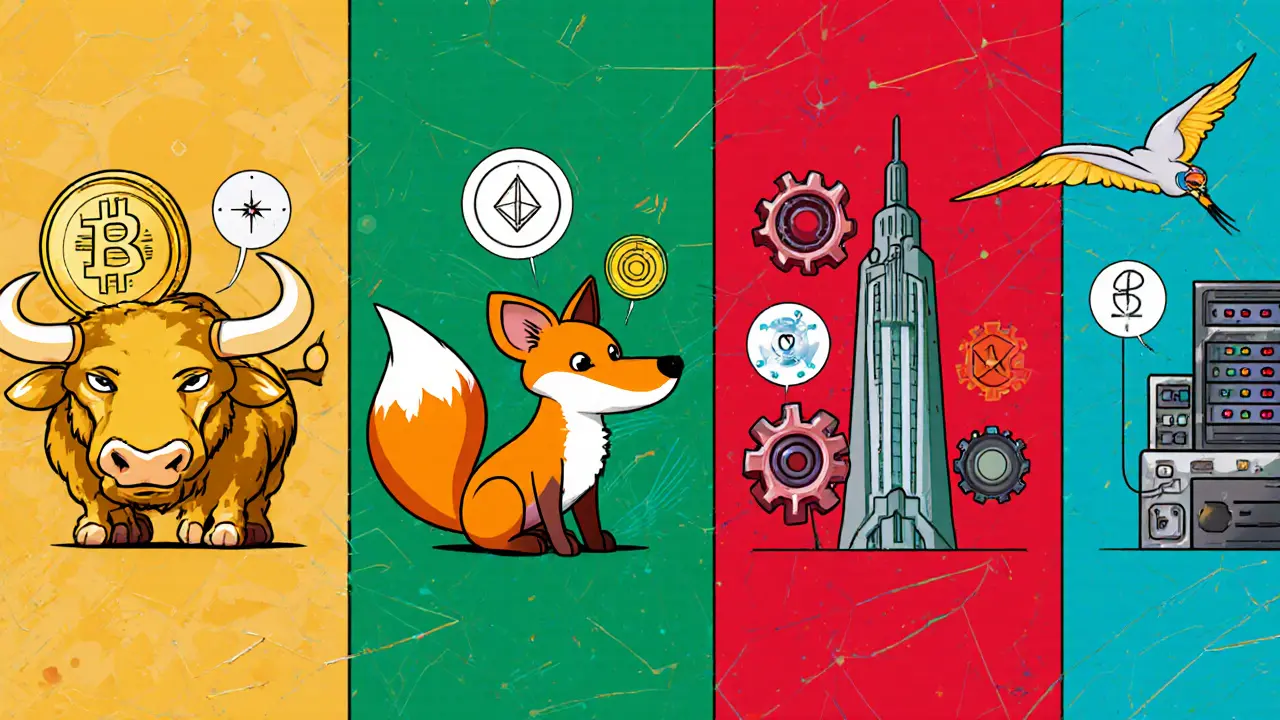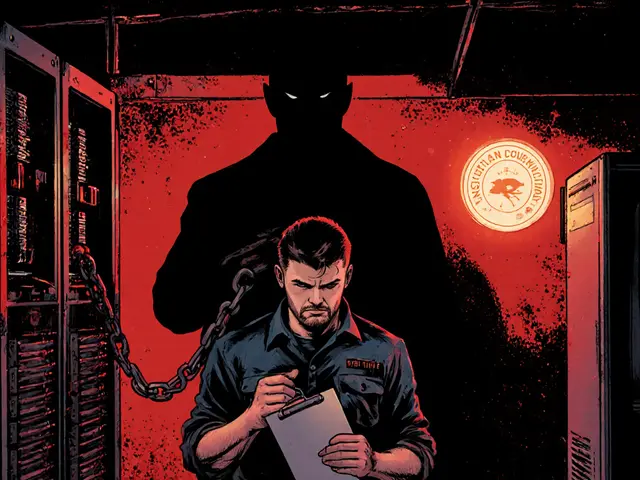Block Reward Comparison Across Blockchains - 2025 Guide
Block Reward Profitability Calculator
Estimated Daily Profitability
Daily Earnings: $0.00
Daily Profit: $0.00
Net Profit Margin: 0%
Block Reward: 0
Block Time: 0
Algorithm: -
If you’ve ever wondered why some coins pour out thousands of tokens per block while others shrink to fractions, you’re in the right place. This block reward comparison breaks down the biggest reward schemes, shows how they impact mining choices, and highlights what the next few years might hold for miners of all backgrounds.
TL;DR
- Bitcoin’s reward is now 3.125BTC and halves every four years; the next halving drops it to 1.5625BTC in 2028.
- Dogecoin and ECASH hand out huge numerical rewards (10,000DOGE, 1,812,500XEC) but rely on lower‑priced tokens.
- ASIC‑resistant coins like Monero (0.6046XMR) and Ravencoin (2,500RVN) let you mine with consumer CPUs/GPUs.
- Kaspa’s 166KAS reward per block comes with a fast blockDAG design, making it attractive for high‑throughput use cases.
- Profitability now depends less on raw reward size and more on hardware costs, electricity rates, and market price volatility.
Below we’ll define what a block reward actually is, then walk through the major blockchains, compare their numbers, and give you a practical checklist for picking a mining target.
What is a Block Reward?
At its core, a block reward is the predetermined amount of cryptocurrency that a miner receives for successfully adding a new block to a proof‑of‑work (PoW) ledger. The reward controls how fast new tokens enter circulation and serves as the primary security incentive for miners.
Bitcoin introduced the concept in 2009 with a 50BTC reward and built in a halving schedule that cuts the reward in half every 210,000 blocks (about four years). Most other PoW chains have borrowed this idea, but they tweak the numbers, timing, and even the algorithm to match their own economic goals.
Why Block Rewards Matter for Miners
Mining income comes from two sources: the block reward and the transaction fees collected from users. Early on, the reward dwarfs fees, but as rewards shrink (think Bitcoin’s upcoming 2028 halving), fees become a bigger portion of a miner’s paycheck.
Reward size also dictates hardware demands. High‑value, low‑reward coins like Bitcoin require specialized ASICs to stay profitable, while low‑value, high‑reward coins such as Dogecoin can be mined on GPUs or even CPUs.
Major Blockchains and Their Reward Structures
Below is a quick snapshot of the most actively mined PoW networks as of October2025. Each entry includes the first‑time micro‑data definition to help search engines understand the entities.
Bitcoin offers a block reward of 3.125BTC, generated roughly every 10 minutes, secured by the SHA‑256 algorithm and mined with ASIC hardware.
Monero provides 0.6046XMR per block, uses the RandomX algorithm, and is intentionally ASIC‑resistant to keep mining accessible to CPUs and GPUs.
Litecoin delivers 6.25LTC per block, runs on the Scrypt algorithm, and is typically mined with ASICs, though GPUs can still be used.
Dogecoin pays a hefty 10,000DOGE per block, shares Scrypt with Litecoin, and welcomes both GPU and ASIC miners.
Zcash issues 1.5625ZEC per block, relies on the Equihash algorithm, and can be mined with GPUs or ASICs.
Kaspa offers roughly 166KAS per block, uses the KHeavyHash algorithm, and is praised for its fast blockDAG architecture.
Ravencoin grants 2,500RVN per block, runs on the ASIC‑resistant KAWPOW algorithm, and is CPU/GPU friendly.
ECASH creates 1,812,500XEC per block every 10 minutes, showcasing how a low‑priced token can sustain large numerical rewards.

Side‑by‑Side Reward Comparison
| Blockchain | Reward per Block | Block Time | Mining Algorithm | Typical Hardware |
|---|---|---|---|---|
| Bitcoin | 3.125BTC | ≈10min | SHA‑256 | ASIC (e.g., Antminer S19) |
| Monero | 0.6046XMR | ≈2min | RandomX | CPU/GPU |
| Litecoin | 6.25LTC | ≈2.5min | Scrypt | ASIC (e.g., Antminer L7) |
| Dogecoin | 10,000DOGE | ≈1min | Scrypt | GPU/ASIC |
| Zcash | 1.5625ZEC | ≈75sec | Equihash | GPU/ASIC |
| Kaspa | ≈166KAS | ≈1sec (DAG) | KHeavyHash | GPU |
| Ravencoin | 2,500RVN | ≈1min | KAWPOW | CPU/GPU |
| ECASH | 1,812,500XEC | ≈10min | SHA‑256 | ASIC (low difficulty) |
How Reward Structures Influence Mining Economics
When you look at the table, the raw numbers can be deceiving. A 10,000‑DOGE block looks massive, but DOGE’s market price hovers around a few cents, translating to a few dollars per block. Conversely, Bitcoin’s 3.125BTC is worth tens of thousands of dollars, even though the block reward is numerically tiny.
Two economic levers drive miner decisions:
- Revenue per hash. This combines reward size, coin price, and fee volume, then divides by the hash rate needed to find a block.
- Cost per hash. Electricity price, hardware depreciation, and cooling affect the bottom line.
Because ASICs are expensive, Bitcoin miners often calculate profit in $/TH/s (dollars per terahash per second). GPU miners, on the other hand, use $/MH/s (megahash) for algorithms like RandomX.
Community reports from 2025 show:
- Bitcoin ASIC rigs (Antminer S19) can earn about $22.55 daily with $8.92 net profit at $0.10/kWh.
- ECASH mining (low‑difficulty SHA‑256) may net $10.87 after the same electricity cost, thanks to its large numerical reward.
- Monero mining on a modern 12‑core CPU yields roughly $1.20 daily - modest, but accessible to anyone with a PC.
Trends Shaping Future Block Rewards
Bitcoin’s next halving in 2028 will drop the reward to 1.5625BTC, tightening the link between miner income and transaction fees. Ethereum’s shift to proof‑of‑stake already proved that fee‑only models can work, and several newer PoW projects are experimenting with “reward‑plus‑fee” hybrids to keep miners motivated.
Environmental concerns are also nudging developers toward lower‑energy algorithms (RandomX, KAWPOW) or even hybrid consensus. Expect more projects to advertise “ASIC‑resistance” as a feature to attract hobbyist miners and decentralize hash power.
Lastly, tokenomics are getting more nuanced. Some chains, like ECASH, issue huge numerical rewards but maintain a low market cap, making them attractive for short‑term profit spikes but risky for long‑term holding.
Choosing the Right Mining Target - A Practical Checklist
- Assess hardware availability. Do you have ASICs, GPUs, or just a desktop CPU? Match the algorithm to your gear.
- Calculate electricity costs. Use a local kWh rate; even a $0.05/kWh difference can swing profitability by 30%.
- Check network difficulty trends. Rising difficulty means your hash power earns less over time.
- Factor in coin price volatility. A 20% price swing can wipe out a day’s profit for high‑reward but low‑price tokens.
- Look at fee dynamics. As block rewards halve, fee volume becomes crucial - Bitcoin and Litecoin are good examples.
- Diversify. Mining two or three coins (e.g., Bitcoin + Monero + Kaspa) spreads risk and keeps your hardware busy.
- Monitor community support. Good documentation, active forums, and frequent updates reduce the learning curve.
By ticking these boxes you can avoid the classic mistake of chasing the “biggest reward” without checking whether the math actually works for you.
Frequently Asked Questions
What exactly does “halving” mean for block rewards?
A halving cuts the block reward in half while keeping the block interval unchanged. Bitcoin halves every 210,000 blocks (~4 years), reducing new BTC supply and tightening miner earnings.
Are ASIC‑resistant coins really safe from large mining farms?
They’re harder to dominate with ASICs, but not impossible. Powerful GPU farms can still take a big share, especially if electricity is cheap. The goal is to keep mining accessible for hobbyists.
How do transaction fees factor into miner profit today?
Fees are added to the block reward. On Bitcoin, fees now make up ~15‑20% of total miner revenue and will rise as the reward shrinks. For low‑reward coins, fees can already be the dominant income source.
Can I mine multiple coins on the same hardware?
Yes, if the algorithms differ. A GPU can switch between RandomX (Monero) and KHeavyHash (Kaspa) with minimal reconfiguration. ASICs are locked to one algorithm, so you’d need separate rigs.
Which coin offers the best balance of reward size and accessibility?
Ravencoin is a strong contender: a 2,500RVN reward, ASIC‑resistant KAWPOW, and decent market price make it profitable for GPU miners in regions with moderate electricity costs.






16 Comments
emmanuel omari
November 4 2024Block reward structures are the backbone of any proof‑of‑work ecosystem, and overlooking their nuances can cost miners dearly. In Africa we have abundant renewable energy, yet many still chase BTC solely because of its headline value. The 3.125 BTC reward translates to massive USD earnings only when electricity is cheap and hardware is top‑tier. Meanwhile, coins like Monero and Ravencoin, with modest per‑block payouts, thrive on CPU‑friendly algorithms that suit our local power grids. Ignoring the algorithmic diversity means missing out on low‑cost mining opportunities that can be profitable even at lower coin prices. The halving schedule of Bitcoin will compress rewards further, pushing miners toward fee‑driven income or alternative chains. ECASH, with its massive numerical reward, shows that token price matters more than raw numbers, a fact often missed by hype‑driven discussions. If you evaluate profitability per hash, you’ll see that a well‑tuned GPU can outperform an under‑utilised ASIC on a low‑margin chain. Energy costs in Lagos hover around $0.07/kWh, allowing modest hash rates to break even on RandomX‑based coins. By contrast, a US‑based miner paying $0.20/kWh must squeeze every ounce of efficiency from their rigs. Diversification across ASIC, GPU, and CPU mining can smooth revenue streams against market volatility. Consider the emerging DAG‑based designs like Kaspa, which promise high throughput without the massive energy draw of SHA‑256. Also factor in transaction fee trends; as block rewards shrink, fees become a larger slice of the pie, especially for Bitcoin and Litecoin. Community data from 2024‑2025 indicate that GPU farms mining KAWPOW consistently beat ASIC rigs on cost per megahash when electricity is under $0.10/kWh. Finally, keep an eye on upcoming protocol upgrades that may tweak difficulty adjustments, as they can swing profitability overnight. In short, a strategic blend of hardware, energy sourcing, and coin selection is essential for sustainable mining in the coming years.
Andy Cox
November 4 2024I appreciate the thorough guide; it’s a solid reference for anyone dipping their toes into mining.
Courtney Winq-Microblading
November 4 2024The dance of block rewards and miner incentives feels almost poetic-a delicate balance between scarcity and abundance, where each coin writes its own verse in the ledger of decentralization. When Bitcoin trims its reward, it whispers a reminder of monetary discipline, while the flamboyant torrents of Dogecoin shout exuberance in numbers. This duality invites us to contemplate not just profit, but the very ethos of value creation in a trustless world. The algorithms themselves-SHA‑256, RandomX, KHeavyHash-are like distinct musical instruments, each resonating with different audiences and hardware symphonies. A miner, then, becomes a conductor, orchestrating hardware, electricity, and market tides into harmonious returns. The guide’s checklist reads like a composer’s score, urging us to tune our instruments before the performance. In this ever‑shifting arena, adaptability is the melody that sustains the longest.
Jayne McCann
November 4 2024Sounds like you’re just glorifying Bitcoin again; there are plenty of other coins that actually give regular income without the hype.
Richard Herman
November 4 2024While Bitcoin’s spotlight is bright, the guide rightly highlights how diverse algorithms open doors for miners with varying resources, making the ecosystem more inclusive.
Stefano Benny
November 4 2024Totally agree-node hash‑rate metrics 📈 and block reward APR 🚀 are the real KPIs, not just the ticker price. #MiningEconomics
Prince Chaudhary
November 4 2024Keep exploring the guide; the more you understand the nuances, the better you’ll position your rig for steady gains.
John Kinh
November 5 2024Same old numbers.
Mark Camden
November 5 2024While brevity can be refreshing, reducing complex economic analyses to a single dismissive statement undermines the diligent research presented, which strives to empower miners with informed decisions.
Evie View
November 5 2024Dismissive remarks about alternative coins ignore the reality that many miners depend on those very networks for sustainable livelihoods, and such blanket statements can be discouraging.
Sidharth Praveen
November 5 2024Optimism in mining comes from diversifying your portfolio-mixing ASIC, GPU, and even CPU operations can buffer against market swings and keep cash flow healthy.
Sophie Sturdevant
November 5 2024Exactly-by allocating hash power strategically across KAWPOW, RandomX, and SHA‑256, you maximize ROI while mitigating volatility; remember to monitor difficulty curves daily.
Nathan Blades
November 5 2024Take this guide as a launchpad: calibrate your hardware, plug in your electricity rates, and watch the profitability dashboard light up-there’s no better time to scale up!
Somesh Nikam
November 5 2024🚀 Great point! Just ensure your power consumption calculations are spot‑on; a small error in kWh estimation can flip profits upside down. 👍
Jan B.
November 5 2024Clear steps, solid advice, keep it concise.
MARLIN RIVERA
November 5 2024The guide glosses over the fact that many of these “promising” coins are outright scams, luring unsuspecting miners into dead‑end projects.